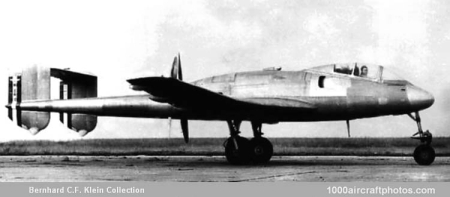Of twin-boom configuration with a sweptback wing – 24 deg inboard and 13.5 deg outboard on the leading edge – and a tricycle landing gear, the Narval (Narwhal) was powered by an Arsenal 12 H-02 (Junkers Jumo 213) engine rated at 2,250 hp, installed as a pusher and driving contra-rotating propellers. Proposed armament comprised six 0.787 in (20 mm) cannon with Provision for up to 2,205 lb (1,000 kg) of external ordnance.
Development was somewhat protracted, and the first flight (by the second prototype, registered F-WFKV, c/n 02) did not take place until April 1, 1949, the first prototype (pictured here) following on December 30. Numerous problems arose during the test program, dictating changes in the control surfaces, the air intakes and the propellers; constant troubles were experienced with the engine, and, following the generally unfavorable results of evaluation at the Centre d'Essais en Vol in January 1950, development of the Narval was discontinued.
The second prototype effected its 43rd and last flight on January 8, 1950, and the first prototype flew only once. Proposals to adapt the design for a Rolls-Royce Nene turbojet as the S.O.8010 were not pursued. The quoted performance was not, in fact, achieved during flight test.
Span: 38 ft 7.33 in (11.77 m)
Length: 38 ft 9.75 in (11.83 m)
Height: 10 ft 6 in (3.20 m)
Wing area: 283.1 sq.ft (26.30 sq.m)
Weight empty: 10,628 lb (4,821 kg)
Loaded weight: 14,563 lb (6,606 kg)
Max speed: 454 mph (730 kmh) at 27,885 ft (8,500 m)
Range: 2,796 mls (4,500 km)
